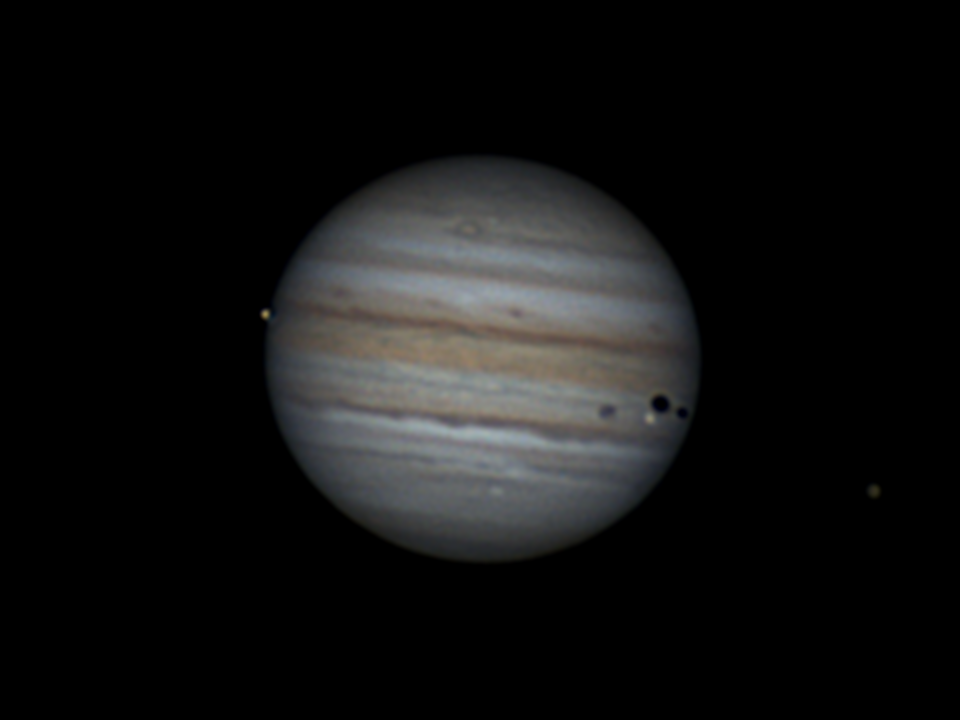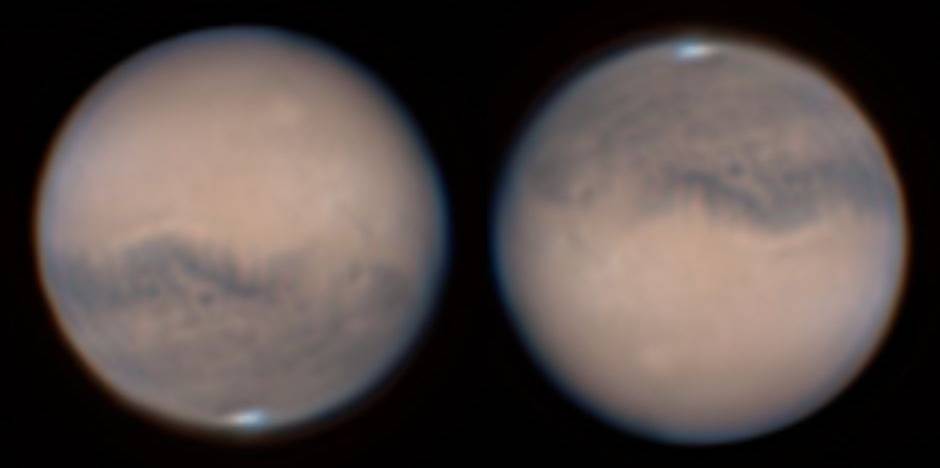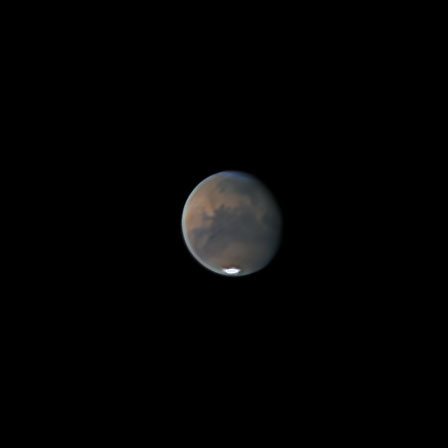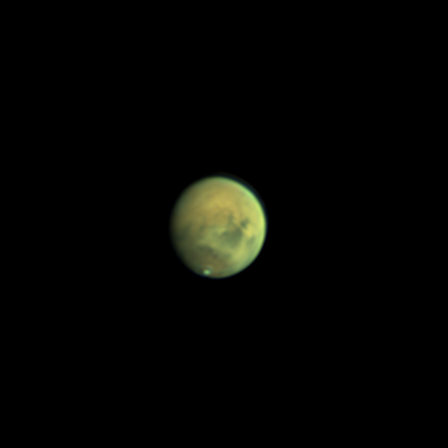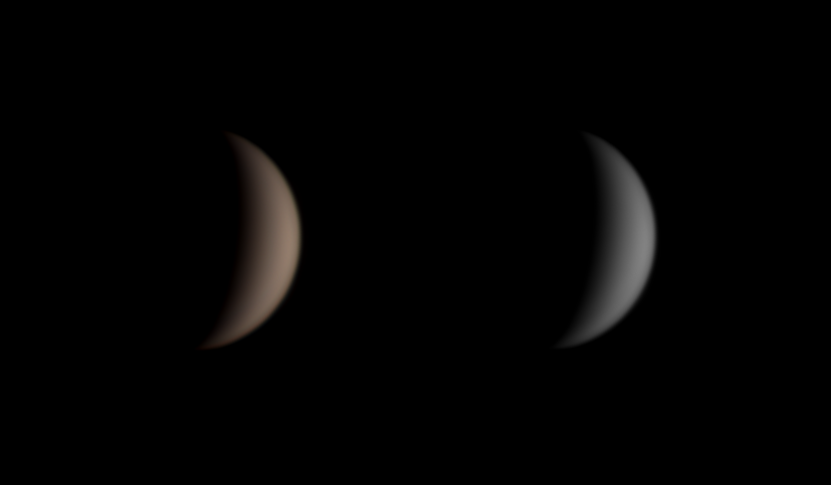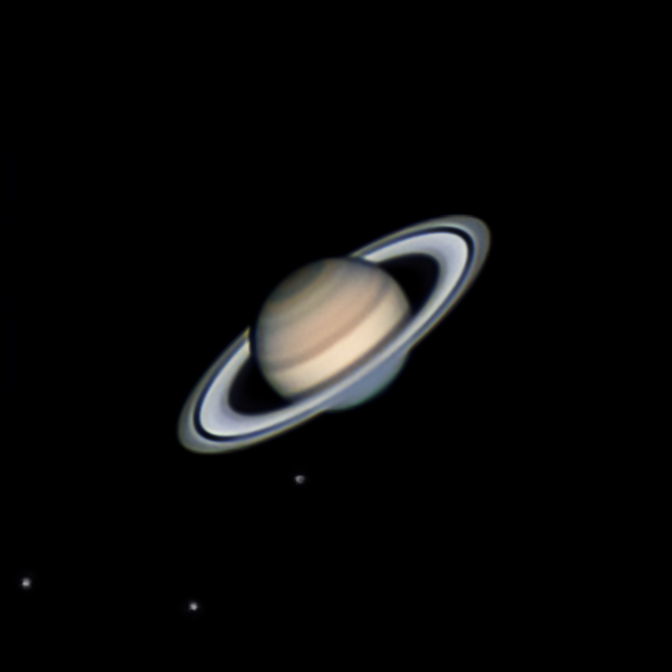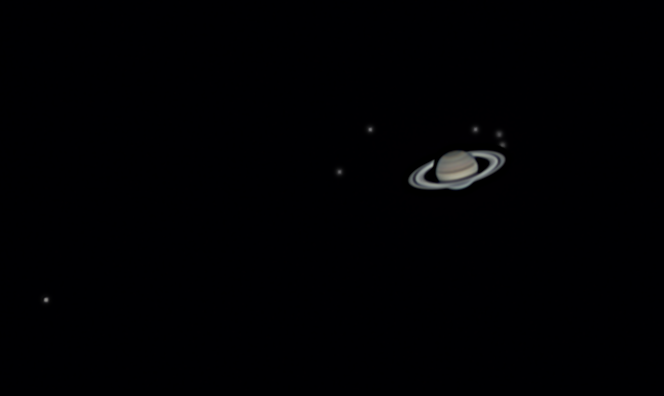I upgraded to an astro dedicated camera and am able to image Mars with greater detail. Despite the light pollution and the restricted views, I have enjoyed every moment I have spent imaging Mars.
I spent almost all of August trying to image Mars and then spending hours on processing the data I would collect. Each day I would collect more than 100GB data and sit down to process and subsequently delete all of it. I didn't like what I was seeing.Contrary to my normal reaction I wasn't frustrated, but more determined to do better. Each day was learning and a good investment of my time.
Initially it was painful just to get Mars on the small chip of my camera, until I found a solution to this. I would first get Mars in my 25mm eyepiece, then add Barlow to the viewing train, remove the 25mm eyepiece, and use a 6.5mm eyepiece. Now this higher eyepiece would be almost the same field of view as my camera sensor, so once I removed the eyepiece and inserted the camera – voila! I would get Mars on my Laptop screen. Then came the struggle of keeping Mars on the sensor as it would drift away in seconds. I would use the drift & pause method which literally means to let the object drift, pause the recording, realign and then restart – insanely time consuming but worth it. I guess being a mother has played a vital role, as patience is a trait we mothers have in abundance:)Come September I liked what I was imaging, and whenever the skies were clear enough to image I would be out and about. Around November 11th I observed the sudden obscurity of the albedo features I was seeing in the past months, and upon checking I found out that a dust storm had actually appeared on Mars!
To put a perspective on what I have witnessed, this has all been happening about 62.07Million Kilometers away from my Balcony.
It was hard for me not to see Mars in 2021 as our orbit has taken us far away from this astonishing world, but we shall meet again in December 2022.
I spent almost all of August trying to image Mars and then spending hours on processing the data I would collect. Each day I would collect more than 100GB data and sit down to process and subsequently delete all of it. I didn't like what I was seeing.Contrary to my normal reaction I wasn't frustrated, but more determined to do better. Each day was learning and a good investment of my time.
Initially it was painful just to get Mars on the small chip of my camera, until I found a solution to this. I would first get Mars in my 25mm eyepiece, then add Barlow to the viewing train, remove the 25mm eyepiece, and use a 6.5mm eyepiece. Now this higher eyepiece would be almost the same field of view as my camera sensor, so once I removed the eyepiece and inserted the camera – voila! I would get Mars on my Laptop screen. Then came the struggle of keeping Mars on the sensor as it would drift away in seconds. I would use the drift & pause method which literally means to let the object drift, pause the recording, realign and then restart – insanely time consuming but worth it. I guess being a mother has played a vital role, as patience is a trait we mothers have in abundance:)Come September I liked what I was imaging, and whenever the skies were clear enough to image I would be out and about. Around November 11th I observed the sudden obscurity of the albedo features I was seeing in the past months, and upon checking I found out that a dust storm had actually appeared on Mars!
To put a perspective on what I have witnessed, this has all been happening about 62.07Million Kilometers away from my Balcony.
It was hard for me not to see Mars in 2021 as our orbit has taken us far away from this astonishing world, but we shall meet again in December 2022.
8" Skywatcher Flextube Dobsonian
ZWO ASI178MC Planetary Camera
Manual Tracking
UV/IR Cut SvBony filter (a filter that helps in stabilizing atmospheric disturbance)
2.5x Powermate Televue (lens to increase focal length magnification)
ZWO ASI178MC Planetary Camera
Manual Tracking
UV/IR Cut SvBony filter (a filter that helps in stabilizing atmospheric disturbance)
2.5x Powermate Televue (lens to increase focal length magnification)
Sharpcap 3
PIPP
ASi3 (Autostakkert 3)
Registax 6
ASi3 (Autostakkert 3)
Registax 6
Video: Jupiter Rotation
4835
40% Stacked in ASi3
RGB24
640x480
AVI files (*.avi)
302
0.005498
>
Adjust
Saturation
Brightness
Distance
Colour
Focus
Observation Log
Since I started imaging Jupiter in August 2020, I have been waiting for a moment to see/image more than one Galilean moon transiting the planet and it happened this year.Due to constraints of my shooting location, I missed Calisto’s shadow transit, but I was able to record Ganymede & Europa transit, and at one point Io appeared from the southern limb of Jupiter, casting a very brief shadow.
This single image has so much going on – the presence of all four Galilean moons in the same frame as Jupiter, so close from our perspective, was indeed an awesome treat.I spent the next two days processing the 206GB of data I recorded.
An indescribable feeling, this was the most magnificent celestial event involving Jupiter that I have experienced. The incredible Universe we are a part of – and some of us are fortunate enough to witness such celestial events, and share them with our community.Jupiter red Spot comparison: In the duration of 45 minutes and 34 seconds, look how the Great Red Spot has changed its position – a simply mind-boggling speed of rotation that the biggest Planet of our Solar System has!
This single image has so much going on – the presence of all four Galilean moons in the same frame as Jupiter, so close from our perspective, was indeed an awesome treat.I spent the next two days processing the 206GB of data I recorded.
An indescribable feeling, this was the most magnificent celestial event involving Jupiter that I have experienced. The incredible Universe we are a part of – and some of us are fortunate enough to witness such celestial events, and share them with our community.Jupiter red Spot comparison: In the duration of 45 minutes and 34 seconds, look how the Great Red Spot has changed its position – a simply mind-boggling speed of rotation that the biggest Planet of our Solar System has!
I upgraded to an astro dedicated camera and am able to image Mars with greater detail. Despite the light pollution and the restricted views, I have enjoyed every moment I have spent imaging Mars.
I spent almost all of August trying to image Mars and then spending hours on processing the data I would collect. Each day I would collect more than 100GB data and sit down to process and subsequently delete all of it. I didn't like what I was seeing.
Contrary to my normal reaction I wasn't frustrated, but more determined to do better. Each day was learning and a good investment of my time.
Initially it was painful just to get Mars on the small chip of my camera, until I found a solution to this. I would first get Mars in my 25mm eyepiece, then add Barlow to the viewing train, remove the 25mm eyepiece, and use a 6.5mm eyepiece. Now this higher eyepiece would be almost the same field of view as my camera sensor, so once I removed the eyepiece and inserted the camera – voila! I would get Mars on my Laptop screen. Then came the struggle of keeping Mars on the sensor as it would drift away in seconds. I would use the drift & pause method which literally means to let the object drift, pause the recording, realign and then restart – insanely time consuming but worth it. I guess being a mother has played a vital role, as patience is a trait we mothers have in abundance:)
Come September I liked what I was imaging, and whenever the skies were clear enough to image I would be out and about. Around November 11th I observed the sudden obscurity of the albedo features I was seeing in the past months, and upon checking I found out that a dust storm had actually appeared on Mars!
To put a perspective on what I have witnessed, this has all been happening about 62.07Million Kilometers away from my Balcony.
It was hard for me not to see Mars in 2021 as our orbit has taken us far away from this astonishing world, but we shall meet again in December 2022
I spent almost all of August trying to image Mars and then spending hours on processing the data I would collect. Each day I would collect more than 100GB data and sit down to process and subsequently delete all of it. I didn't like what I was seeing.
Contrary to my normal reaction I wasn't frustrated, but more determined to do better. Each day was learning and a good investment of my time.
Initially it was painful just to get Mars on the small chip of my camera, until I found a solution to this. I would first get Mars in my 25mm eyepiece, then add Barlow to the viewing train, remove the 25mm eyepiece, and use a 6.5mm eyepiece. Now this higher eyepiece would be almost the same field of view as my camera sensor, so once I removed the eyepiece and inserted the camera – voila! I would get Mars on my Laptop screen. Then came the struggle of keeping Mars on the sensor as it would drift away in seconds. I would use the drift & pause method which literally means to let the object drift, pause the recording, realign and then restart – insanely time consuming but worth it. I guess being a mother has played a vital role, as patience is a trait we mothers have in abundance:)
Come September I liked what I was imaging, and whenever the skies were clear enough to image I would be out and about. Around November 11th I observed the sudden obscurity of the albedo features I was seeing in the past months, and upon checking I found out that a dust storm had actually appeared on Mars!
To put a perspective on what I have witnessed, this has all been happening about 62.07Million Kilometers away from my Balcony.
It was hard for me not to see Mars in 2021 as our orbit has taken us far away from this astonishing world, but we shall meet again in December 2022
Since Venus is very, very bright, it could be considered easy to capture, but this is not the case. In fact, it's one of the most difficult planets to image!
My living space happens to be on the first floor surrounded by buildings. However, since I have balconies in three directions (north facing, south-east facing and south-southwest facing) I could image Venus, which was on its southern elongation. This balcony is not at all conducive for imaging as it has a pigeon net cover, but I have even managed to use this pigeon net as a Bahtinov mask (shhhh...big secret). The sessions here are tight on time as well, I could only image for max 15 minutes as Venus disappeared behind a building
The lugging of equipment for 15 minutes of imaging, and only 2 successful sessions out of 8, was all worth it. The visuals of Venus at 30% phase are just phenomenal. It looked like a steel gray sphere, so so metallic – an indescribable feeling as you look at it thru an eyepiece.
My goal is to image Venus with its cloud bands, which is very, very difficult to get from my aperture but with good seeing conditions it is doable. I shall continue my quest and hope that Delhi skies also cooperate to fulfill this.
My living space happens to be on the first floor surrounded by buildings. However, since I have balconies in three directions (north facing, south-east facing and south-southwest facing) I could image Venus, which was on its southern elongation. This balcony is not at all conducive for imaging as it has a pigeon net cover, but I have even managed to use this pigeon net as a Bahtinov mask (shhhh...big secret). The sessions here are tight on time as well, I could only image for max 15 minutes as Venus disappeared behind a building
The lugging of equipment for 15 minutes of imaging, and only 2 successful sessions out of 8, was all worth it. The visuals of Venus at 30% phase are just phenomenal. It looked like a steel gray sphere, so so metallic – an indescribable feeling as you look at it thru an eyepiece.
My goal is to image Venus with its cloud bands, which is very, very difficult to get from my aperture but with good seeing conditions it is doable. I shall continue my quest and hope that Delhi skies also cooperate to fulfill this.
While I waited for the special three moon transit on Jupiter, Saturn came up, and I couldn't waste the opportunity to image. Just before imaging, I visually observed Saturn and I was thrilled to see this magnificent planet with few of its moons.
Besides capturing Encledaeus, Tethys and Dione I was able to see more clearly the southern hemisphere of Saturn, the bluish bulge! The Cassini division is also well defined alongside the visible bands. Saturn is farther away from Jupiter and Earth, hence it appears dim, and to image these intricate details is always a thrill.
Image 1: Saturn and the Seeliger effect
This was the coolest thing to capture, if you knew what you were looking at :) Saturn was at opposition on the 2nd August. I was so lucky to see as well as image the Seeliger effect, which is when its rings appear about as bright as the planet's sphere. This phenomenon of rings intensifying in apparent brightness happens for a few days around the time of opposition only.
Image 2: Saturn’s Moons
Saturn with Six of its moons. The seeing was very good indeed to capture this many moons, though I had to zoom out to image all of them together. In the image are from the farthest Titan, Dione, Rhea, Tethys, Enceladus, Mimas
Besides capturing Encledaeus, Tethys and Dione I was able to see more clearly the southern hemisphere of Saturn, the bluish bulge! The Cassini division is also well defined alongside the visible bands. Saturn is farther away from Jupiter and Earth, hence it appears dim, and to image these intricate details is always a thrill.
Image 1: Saturn and the Seeliger effect
This was the coolest thing to capture, if you knew what you were looking at :) Saturn was at opposition on the 2nd August. I was so lucky to see as well as image the Seeliger effect, which is when its rings appear about as bright as the planet's sphere. This phenomenon of rings intensifying in apparent brightness happens for a few days around the time of opposition only.
Image 2: Saturn’s Moons
Saturn with Six of its moons. The seeing was very good indeed to capture this many moons, though I had to zoom out to image all of them together. In the image are from the farthest Titan, Dione, Rhea, Tethys, Enceladus, Mimas
Equipment:
8" Skywatcher Flextube Dobsonian
ZWO ASI178MC Planetary Camera
EQ Platform (single Stepper motor driven platform tracking in alt azimuth mode)
UV/IR Cut SvBony filter (a filter that helps in stabilizing atmospheric disturbance)
2.5x Powermate Televue (lens to increase focal length magnification)
ZWO ASI178MC Planetary Camera
EQ Platform (single Stepper motor driven platform tracking in alt azimuth mode)
UV/IR Cut SvBony filter (a filter that helps in stabilizing atmospheric disturbance)
2.5x Powermate Televue (lens to increase focal length magnification)
8" Skywatcher Flextube Dobsonian
ZWO ASI178MC Planetary Camera
Manual Tracking
UV/IR Cut SvBony filter (a filter that helps in stabilizing atmospheric disturbance)
2.5x Powermate Televue (lens to increase focal length magnification)
ZWO ASI178MC Planetary Camera
Manual Tracking
UV/IR Cut SvBony filter (a filter that helps in stabilizing atmospheric disturbance)
2.5x Powermate Televue (lens to increase focal length magnification)
8" Skywatcher Flextube Dobsonian
ZWO ASI178MC Planetary Camera
EQ Platform (single Stepper motor driven platform tracking in alt azimuth mode)
UV/IR Cut SvBony filter (a filter that helps in stabilizing atmospheric disturbance)
2.5x Powermate Televue (lens to increase focal length magnification)
ZWO ASI178MC Planetary Camera
EQ Platform (single Stepper motor driven platform tracking in alt azimuth mode)
UV/IR Cut SvBony filter (a filter that helps in stabilizing atmospheric disturbance)
2.5x Powermate Televue (lens to increase focal length magnification)
8" Skywatcher Flextube Dobsonian
EQ Platform (single motor driven platform tracking in alt azimuth mode)
2x Barlow Celestron (lens to increase focal length and magnification)
UV/IR Cut SvBony filter (a filter that helps in stabilizing atmospheric disturbance)
2.5x Powermate Televue ZWO ASI178MC (lens to increase focal length magnification)
EQ Platform (single motor driven platform tracking in alt azimuth mode)
2x Barlow Celestron (lens to increase focal length and magnification)
UV/IR Cut SvBony filter (a filter that helps in stabilizing atmospheric disturbance)
2.5x Powermate Televue ZWO ASI178MC (lens to increase focal length magnification)
Capturing Software
Sharpcap 3
Post Processing
PIPPASI3
(Autostakkert 3)
Registax 6
(Autostakkert 3)
Registax 6
>
Camera Settings
Sharpcap 3
Sharpcap 3
Sharpcap 3
Color Space
RGB24
>
Capture Area
640x480
>
Binning
1
>
Output Format
AVI foles (*.avi)
>
Delayer Preview
On
>
Gain
Auto
333
Exposure
0.004232
☑ LX Mode
